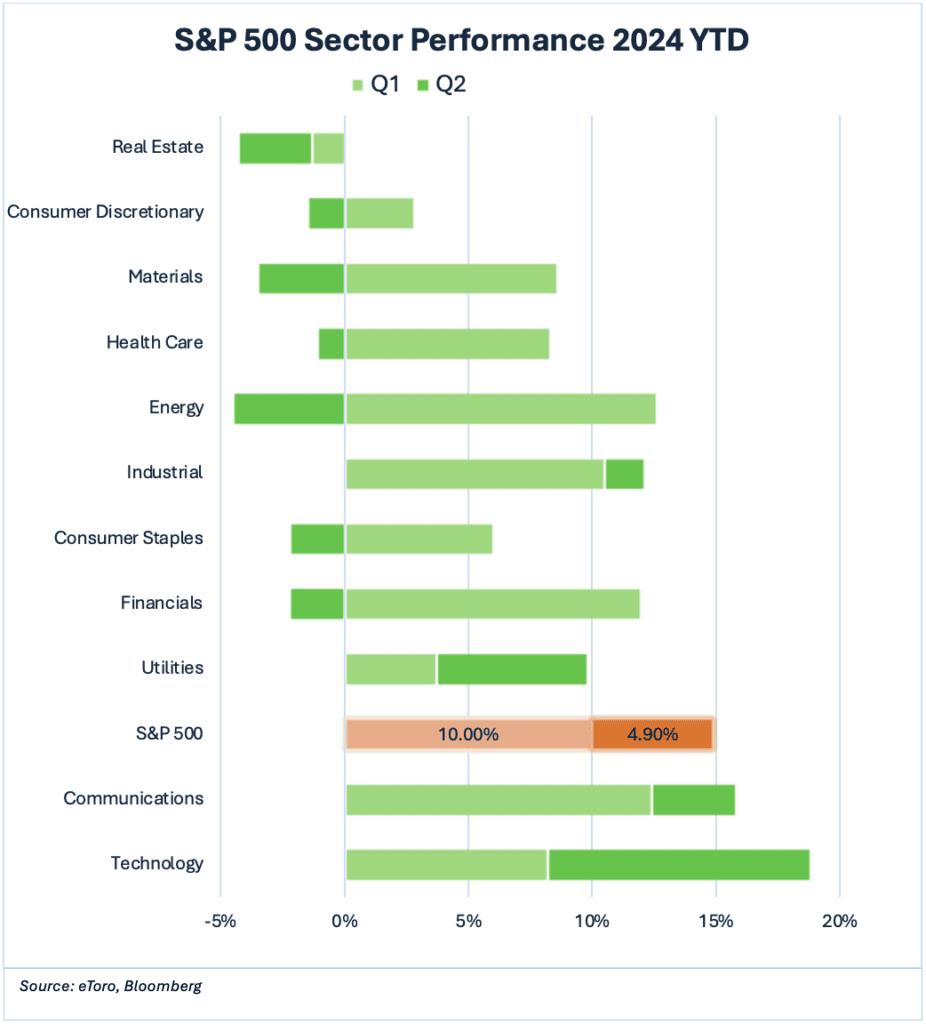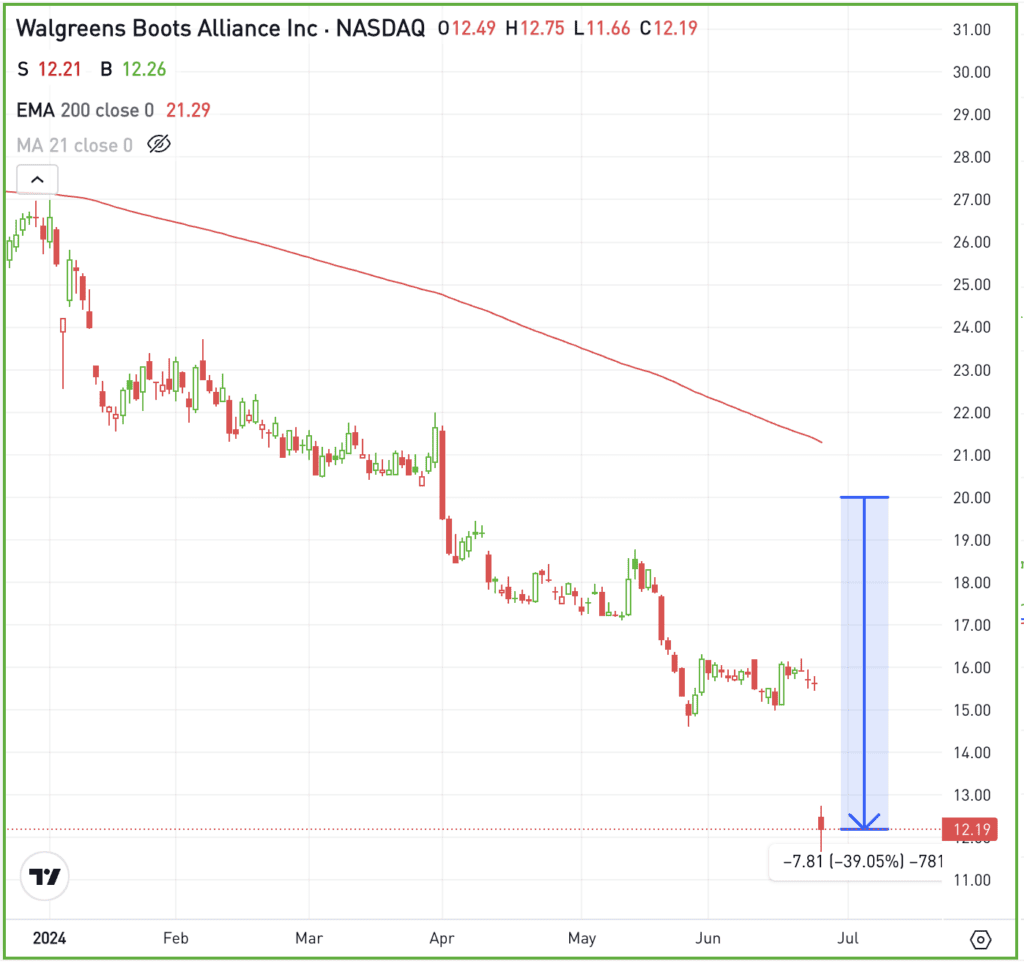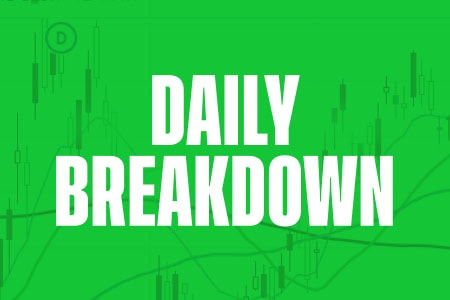The Daily Breakdown looks at the 11 S&P 500 sectors as Q2 comes to an end, with the S&P 500 index up about 15% on the year.
Friday’s TLDR
- The S&P 500 is up almost 5% for the quarter.
- Tech and communications led the charge in Q2.
- How options can help limit losses.
What’s happening?
Sometimes it pays to be diversified, like in the first quarter when 10 of the 11 S&P 500 sectors finished higher and the index as a whole gained about 10%. Other times, like in Q2, the environment shifts more to what’s called a “stock picker’s market.”
We have just one trading session left in the second quarter (and the first half) of 2024, and it’s set to be a doozy with the PCE report due up at 8:30 a.m. ET and the Russell Reconstitution.
But barring a truly catastrophic session for the bulls, the S&P 500 is set to round out the quarter with another solid gain, as it’s currently up 4.7% in Q2.
Despite a pretty solid quarterly gain for the index, it’s interesting that just five out of the 11 sectors are higher so far this quarter — (and until yesterday’s pop in the consumer discretionary sector, that tally stood at just four out of the 11 sectors).
Where has the strength been?

While Q1 featured broad strength and participation in the rally, the gains in Q2 were much more concentrated. That rally was led by tech, which is up nearly 9% with a day to go.
Communications and utilities round out the No. 2 and No. 3 spots, with gains of about 6% apiece. Consumer staples currently sport a quarter-to-date gain of 1.3%, while consumer discretionary stocks are up just 0.4%.
This compares to Q1, which had seven out of the 11 sectors rally at least 8% (and four increase by a double-digit percentage).
Is this good or bad?
In an ideal world, more participation is almost always the better scenario when it comes to market rallies. Known as “breadth,” investors like when the market is moving in unison.
The cons are simple. Narrowing leadership puts increased concentration risk on a smaller number of stocks. If they fall without other stocks or sectors picking up the slack — and in particular, if they fall fast and hard — the S&P 500, Nasdaq 100, Dow and other indices can come down in a hurry, too.
The pros are straight-forward as well.
On the plus side, narrowed breadth leaves room for breadth expansion down the road. That’s when money rotates throughout the market and helps give other stocks a boost.
Lastly, these types of environments can be rewarding for investors who have a knack for picking out winners and riding them higher. In other words, a stock-pickers market — which is where we find ourselves at the moment.
Now the question becomes, will this continue in Q3 or will we see another character change like we did between Q1 and Q2?
Want to receive these insights straight to your inbox?
The setup — WBA
Despite our discussion on a stock picker’s market, I want to look at the risk of buying what many in the industry call a “falling knife.” To illustrate, we’re looking at Walgreens.
I’m not trying to single out WBA, but there have been many moments where investors argued that its valuation was too cheap and the dividend was too attractive.
I can’t argue for or against that logic, but I can point to the chart and argue that investors who have continued to buy this name have been hurt, as punctuated by the stock’s 22% plunge on Thursday to new multi-year lows.

I’m not saying this to shame anyone who may have found themselves in a losing position and struggling to bite the bullet and get out. But rather, I write it as a reminder for why investors need to be disciplined and acknowledge when a thesis breaks down and it may be time to bail.
Options
In some ways, this is where options can be an investor’s friend. Like everything good in life, moderation is important. Translated to the investing world, position sizing is key.
Had investors bought 100 shares of WBA at $20 a couple of months ago, they’d be down about $775 or around 40%. Now for example, say they bought the July $20 call option instead, paying about $200 at that time.
Now admittedly, they’d be down close to 100% on their position and that’s no fun either. But because they only paid $200 for the option, the actual dollar loss of the investment wasn’t nearly as bad vs. the 100 shares of common stock.
Not every situation is as cut and dry as this type of example, and had the investor took on too much size — say, buying 5 of the calls for $200 apiece (for a total of $1,000) rather than just one call option — they’d be in just as bad or worse of a position than if they had bought the stock.
This is where a lot of options traders get into trouble, because the reality is, a little bit goes a long way in this market. It’s food for thought, but something to consider.
To learn more about options, consider visiting the eToro Academy.
Disclaimer:
Please note that due to market volatility, some of the prices may have already been reached and scenarios played out.



